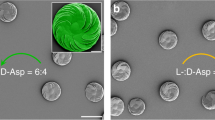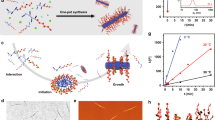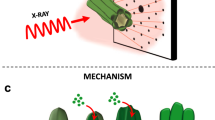Abstract
Morphosynthesis strategies inspired by biomineralization processes gives access to a wide range of fascinating and useful crystalline mesostructures1,2,3. Biomimetic synthesis of inorganic materials with complex shapes can now be used to control the nucleation, tensorial growth, and alignment of inorganic crystals in a way previously not practicable3. Double hydrophilic block copolymers (DHBCs)4 consisting of a hydrophilic block strongly interacting with inorganic minerals, and a non-interacting hydrophilic block, were recently introduced for the control of mineralization reactions. DHBCs are 'improved versions' of the previously used polyelectrolytes or amphiphiles and are extraordinarily effective in crystallization control5,6,7,8,9. Here, we report on the formation of helices of achiral BaCO3 nanocrystals in the presence of a racemic DHBC suggesting that a helical alignment can be induced by racemic polymers through selective adsorption on the (110) face of nanocrystals. This mechanism is the key for a better understanding of the self-assembly of chiral organic–inorganic superstructures that don't follow a direct template route.
This is a preview of subscription content, access via your institution
Access options
Subscribe to this journal
Receive 12 print issues and online access
$259.00 per year
only $21.58 per issue
Buy this article
- Purchase on Springer Link
- Instant access to full article PDF
Prices may be subject to local taxes which are calculated during checkout




Similar content being viewed by others
References
Mann, S. The chemistry of form. Angew. Chem. Int. Edn 39, 3392–3406 (2000).
Cölfen, H. & Mann, S. Emergence of higher-order organization by mesoscale self-assembly and transformation of hybrid nanostructures. Angew. Chem. Int. Edn 42, 2350–2365 (2003).
Estroff, L. A. & Hamilton, A. D. At the interface of organic and inorganic chemistry: Bioinspired synthesis of composite materials Chem. Mater. 13, 3227–3235 (2001).
Cölfen, H. Double-hydrophilic block copolymers: Synthesis and application as novel surfactants and crystal growth modifiers. Macromol. Rapid Commun. 22, 219–252 (2001).
Antonietti, M. et al. Inorganic/organic mesostructures with complex architectures: Precipitation of calcium phosphate in the presence of double-hydrophilic block copolymers. Chem. Eur. J. 4, 2493–2500 (1998).
Marentette, J. M., Norwig, J., Stockelmann, E., Meyer, W. H. & Wegner, G. Crystallization of CaCO3 in the presence of PEO-block-PMAA copolymers. Adv. Mater. 9, 647–651 (1997).
Yu, S. H., Cö lfen, H. & Antonietti, M. Control of the morphogenesis of barium chromate by using double-hydrophilic block copolymers (DHBCs) as crystal growth modifiers. Chem. Eur. J. 8, 2937–2945 (2002).
Qi, L. M., Cölfen. H. & Antonietti, M. Crystal design of barium sulfate using double-hydrophilic block copolymers. Angew. Chem. Int. Edn 39, 604–607 (2000).
Robinson, K. L., Weaver, J. V. M., Armes, S. P., Marti, E. D. & Meldrum, F. C. Synthesis of controlled-structure sulfate-based copolymers via atom transfer radical polymerisation and their use as crystal habit modifiers for BaSO4 . J. Mater. Chem. 12, 890–896 (2002).
Xia, Y. et al. One-dimensional nanostructures: synthesis, characterization, and applications. Adv. Mater. 15, 353–389 (2003).
Sone, E. D., Zubarev E. R. & Stupp, S. I. Semiconductor nanohelices templated by supramolecular ribbons. Angew. Chem. Int. Edn 41, 1706–1709 (2002).
Zhang, H. F., Wang, C. M. & Wang, L. S. Helical crystalline SiC/SiO2 core-shell nanowires. Nano Lett. 2, 941–944 (2002).
Sato, I. et al. Highly enantioselective synthesis of organic compound using right- and left-handed helical silica. Tetrahedr. Lett. 44, 721–724 (2002).
van Bommel, K. J. C., Friggeri. A. & Shinkai, S. Organic templates for the generation of inorganic materials. Angew. Chem. Int. Edn 42, 980–999 (2003).
Sugawara, T., Suwa, Y., Ohkawa, K. & Yamamoto, H. Chiral biomineralization: Mirror-imaged helical growth of calcite with chiral phosphoserine copolypeptides. Macromol. Rapid Commun. 24, 847–851 (2003).
Gower L. A. & Tirrell, D. A. Calcium carbonate films and helices grown in solutions of poly(aspartate). J. Crystal Growth 191, 153–160 (1998).
García-Ruiz, J. M. et al. Self-assembled silica-carbonate structures and detection of ancient microfossils. Science 302, 1194–1197 (2003).
Garcia-Ruiz J. M. & Amoros J. L. Crystal aggregates with induced morphologies grown by silica gel technique. Bull. Mineral. 104, 107–113 (1981).
Imai, H. & Oaki, Y. Emergence of morphology chirality from twinned crystals. Angew. Chem. Int. Edn 43, 1363–1368 (2004).
Terada, T., Yamabi, S. & Imai, H. Formation process of sheets and helical forms consisting of strontium carbonate fibrous crystals with silicate. J. Crystal Growth 253, 435–444 (2003).
Tauer, K., Antonietti, M., Rosengarten, L. & Müller, H. Initiators based on poly(ethylene glycol) for starting heterophase polymerizations: generation of block copolymers and new particle morphologies. Macromol. Chem. Phys. 199, 897–908 (1998).
Odian, G. Principles of Polymerization, Third Edition 625–626 (Wiley, New York, 1991).
Sommerdijk, N. A. J. M., Holder, S. J., Hiorns, R. C., Jones, R. G. & Nolte, R. J. M. Self-assembled structures from an amphiphilic multiblock copolymer containing rigid semiconductor segments. Macromolecules 33, 8289–8294 (2000).
Cornelissen, J. J. L. M., Rowan A. E., Nolte R. J. M. & Sommerdijk, N. A. J. M. Chiral architectures from macromolecular building blocks. Chem. Rev. 101, 4039–4070 (2001).
Weiner, S., Albeck, S. & Addadi, L. Polysaccharides of intracrystalline glycoproteins modulate calcite crystal growth in vitro. Chem. Eur. J. 2, 278–284 (1996).
Tang, Z. Y., Kotov. N. A. & Giersig. M. Spontaneous organization of single CdTe nanoparticles into luminescent nanowires. Science 297, 237–240 (2002).
Qi, L. M. et al. Formation of BaSO4 fibres with morphological complexity in aqueous polymer solutions. Chem. Eur. J. 7, 3526–3532 (2001).
Yu, S. H., Antonietti, M., Cölfen, H. & Hartmann, J. Growth and self-assembly of BaCrO4 and BaSO4 nanofibers toward hierarchical and repetitive superstructures by polymer-controlled mineralization reactions. Nano Lett. 3, 379–382 (2003).
Travaille, A. M. et al. Aligned growth of calcite crystals on a self-assembled monolayer. Adv. Mater. 14, 492–495 (2002).
Penn, R. L. & Banfield, J. F. Morphology development and crystal growth in nanocrystalline aggregates under hydrothermal conditions: Insights from titania. Geochim. Cosmochim. Acta 63, 1549–1557 (1999).
Acknowledgements
We thank the Max Planck Gesellschaft and the Deutsche Forschungsgemeinschaft for financial support. S. H. Yu thanks the special funding support from the Chinese Academy of Sciences the Distinguished Youth and Team Funds from the National Science Foundation of China (No. 20325104, No. 20321101), and NSFC No. 50372065, AvH Foundation, and Max Planck Society). The authors thank the Ivoclar AG (Schaan, Liechtenstein) for the gift of the (2-[4-dihydroxy phosphoryl]-2-oxabutyl) monomer. A. Völkel is acknowledged for the ultracentrifuge experiments.
Author information
Authors and Affiliations
Corresponding authors
Ethics declarations
Competing interests
The authors declare no competing financial interests.
Supplementary information
Supplementary Information
Fig S1, Fig S2, Fig S3, Fig S4, Fig S5, Fig S6 (PDF 505 kb)
Rights and permissions
About this article
Cite this article
Yu, SH., Cölfen, H., Tauer, K. et al. Tectonic arrangement of BaCO3 nanocrystals into helices induced by a racemic block copolymer. Nature Mater 4, 51–55 (2005). https://doi.org/10.1038/nmat1268
Received:
Accepted:
Published:
Issue Date:
DOI: https://doi.org/10.1038/nmat1268
This article is cited by
-
Twisting, untwisting, and retwisting of elastic Co-based nanohelices
Nature Communications (2023)
-
Tuning organic crystal chirality by the molar masses of tailored polymeric additives
Nature Communications (2021)
-
Frustrated self-assembly of non-Euclidean crystals of nanoparticles
Nature Communications (2021)
-
Lead carbonate hydroxide nanostructures: a new hydrothermal synthesis in the presence of ethylenediamine and hydrazine and investigation photocatalytic behavior
Journal of Materials Science: Materials in Electronics (2019)
-
A facile synthesis of nanosheet-structured barium carbonate spheres with a superior adsorption capacity for Cr(VI) removal
Journal of Materials Science (2018)



